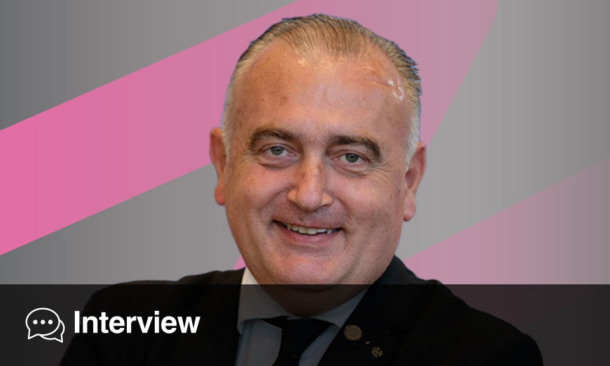Interviewees: Giovanni Palladini1,2
1. Amyloidosis Research and Treatment Centre Foundation, San Matteo, Italy
2. Department of Molecular Medicine, University of Pavia, Italy
Disclosure: Palladini has received honoraria from Alexion, Janssen, Prothena, and Sebia.
Acknowledgements: Medical writing assistance was provided by Amanda Barrell, Brighton, UK.
Disclaimer: The opinions expressed in this article belong solely to the named interviewees.
Support: The publication of this article was funded by Alexion Pharmaceuticals.
Citation: EMJ Cardiol. 2023;11[Suppl 1]:2-5. DOI/10.33590/emjcardiol/10309873. https://doi.org/10.33590/emjcardiol/10309873.
Meeting Summary
Amyloid light-chain (AL) amyloidosis is a rare systemic disease caused by plasma cell dyscrasia. These plasma cells produce excess Ig light chains, which can misfold, aggregate, and deposit in tissues, resulting in toxicity and organ dysfunction. The heart is among the most commonly affected organs and cardiac involvement is associated with significantly worse outcomes. Despite advances in the treatment of the underlying plasma cell dyscrasia, the survival of patients with advanced heart involvement is extremely poor. The median survival of patients with cardiac AL can be as short as 6 months from diagnosis, depending on severity of cardiac involvement.AMYLOID LIGHT-CHAIN AMYLOIDOSIS OVERVIEW
AL amyloidosis is a life-threatening disease caused by plasma cell dyscrasia and can affect multiple organs, including the heart and kidneys. Small plasma cell clones or, more rarely, B cell clones produce monoclonal free light chains (FLC) that misfold and aggregate, forming insoluble amyloid fibrils, which are deposited in body tissue.1 The accumulation of amyloid deposits leads to tissue damage and organ dysfunction,2 while amyloid FLC can also cause cytotoxicity.3
It is a rare condition, with approximately 40.5 cases per million people in 2015 in the USA.2 Prevalence increases in line with age and the majority of patients are over the age of 65 years.2
Palladini said: “Almost all organs can be affected by this condition. The most common are the heart, the kidneys, and the liver, but also the peripheral nervous system, the soft tissues, and so on.4 It can be localised or systemic, and when systemic disease affects the vital organs, it is usually a very severe condition.” Patients with advanced stage disease with cardiac involvement are at high risk of mortality, Palladini went on. The median survival of patients with cardiac AL can be as short as 6 months from diagnosis, depending on severity of cardiac involvement.4
UNMET NEEDS IN AMYLOID LIGHT-CHAIN AMYLOIDOSIS DIAGNOSIS
Despite such dire potential consequences, the condition is often missed, said Palladini. “If the patient knows they have a monoclonal component, they are followed by a haematologist and, sometimes, they will be detected early, at a pre-symptomatic stage,” Palladini said. “More often, however, the patient will experience symptoms.” These may include heart failure with peripheral fluid retention and dyspnoea, nephrotic syndrome with fluid retention and hepatomegaly, and peripheral and autonomic neuropathy.5 “AL amyloidosis is difficult to diagnose because it mimics other conditions and, when there is single organ involvement, there is a lack of clues. If you have a patient with heart failure and nephrotic syndrome, for instance, you may think of amyloid. But if it is just heart failure, it can be more difficult.” Diagnosis is often delayed, and 20% of patients with AL amyloidosis are not correctly diagnosed until 2 years or more after becoming symptomatic.5
A lack of awareness of the condition among cardiologists can also hamper effective diagnosis in patients presenting with HF, Palladini went on. Studies have shown that up to 29% of patients with HF with preserved ejection fraction have cardiac amyloidosis.6 Yet, while cardiologists often consider wild-type amyloid transthyretin (ATTRwt) amyloidosis during diagnostic workup, the same does not tend to be true for AL amyloidosis. “ATTRwt is probably more prevalent, and clinicians are better trained in detecting it,” Palladini said, highlighting an important distinction between the two conditions. “ATTRwt progresses over years, but cardiac AL amyloidosis progresses over weeks.7 If you see a patient and do not think of AL, you will miss the condition and the patient will die during the diagnostic procedures.”
Palladini believes every patient with suspected cardiac amyloidosis should be screened for monoclonal gammopathy. “Cardiologists could be facing a medical emergency and not be aware of it if they are only thinking of ATTRwt amyloidosis,” Palladini said, explaining that the two will appear the same on echocardiogram.
Looking for a monoclonal component “is very easy” with adequate technology, Palladini said. Serum FLC ratio in addition to immunofixation electrophoresis of both serum and urine has a 99% sensitivity for monoclonal gammopathy,8 and so should be carried out regardless of serum protein electrophoresis results. If the result is positive, the patient will need a biopsy at a referral centre. If the screening does not show a monoclonal protein, “you have time to look for ATTRwt,” Palladini went on.
UNMET NEEDS IN AMYLOID LIGHT-CHAIN AMYLOIDOSIS TREATMENT
AL amyloidosis will be diagnosed and staged, according to the Mayo Clinic system9,10 or the most recent Mayo Clinic European modification,11 at a specialist referral centre. “We need cardiologists to send their patients to us as early as possible,” Palladini said, explaining that current treatment options were slow acting. Typically, the initial regimen is administered over 6 months, followed by a maintenance regimen for a further 24 months.12 Supportive care, Palladini went on, is delivered by amyloidologists and cardiologists working in partnership over the course of the disease.
Palladini explained that the presentation of patients with AL amyloidosis was “extremely heterogeneous” and that response to therapy was variable. “You have patients without heart involvement who can live longer, even if they do not respond to treatment, and you have patients with very advanced heart involvement for whom the opposite is true. These patients may only survive a few months and can die even if they do respond to treatment.”
Current treatment approaches focus on using anti-plasma cell chemotherapy or immunotherapy to eradicate the precursor clone, with the standard of care in the USA and Europe being daratumumab plus cyclophosphamide/bortezomib/dexamethasone (DARA+CyBorD).13 “If you kill the plasma cell, the concentration of light chains drops, the whole process stops. If you stop the production, you eradicate the toxic precursor, but the amyloid deposits are still there,” Palladini explained, adding that damage reversal was a slow process. Stem cell transplantation could be considered in eligible patients with an inadequate response to DARA+CyBorD, Palladini said.14 However, advanced heart involvement contraindicates stem cell transplant.15
“With the exception of European modification Stage IIIb patients, we see a complete response (CR), meaning you no longer see the monoclonal protein, in approximately 55% of cases with DARA-based therapy. At 6 months, approximately 40–50% of patients achieve organ response or cardiac improvement.”14 Such statistics leave much room for improvement, Palladini went on. “It is much better than what we could do in the past, but it is still not enough. We want 100% CR rates, and we want 100% cardiac response rates.”
There are clear unmet needs for treating advanced disease, in which DARA+CyBorD is not indicated; treating refractory disease; preventing relapse; and removing the amyloid deposits, Palladini said.
FUTURE TREATMENT OPTIONS
Researchers are currently attempting to address these unmet needs in a variety of ways.
Approaches have included ‘borrowing’ drugs from multiple myeloma to treat relapsed/refractory AL amyloidosis. Patients with a 11;14 translocation, which accounts for approximately 50% of people with AL amyloidosis, may benefit from inhibition of the BLC2 gene, for example.16 Studies of chimeric antigen receptor T-cell therapy have also yielded interesting results in patients who were heavily pre-treated and refractory. “Only five patients have so far been reported, but the results were extraordinary,” said Palladini. All achieved CR. “It is encouraging, but it is a very complicated treatment to deliver, and our patients are very frail.”17,18
In terms of fostering cardiac response in patients with advanced disease, attention has turned to using passive immunotherapy to neutralise existing amyloid deposits. Two antibodies, birtamimab and CAEL-101, are currently under investigation.
While two studies of birtamimab, formerly NEOD001, were halted in 2019 due to futility, a post hoc analysis of the results found a significant survival advantage among patients with Mayo Stage IV or advanced disease.19 This, Palladini explained, has led to the design of a randomised, placebo-controlled, Phase III trial in this cohort, which is currently enrolling.20
CAEL-101 has long been recognised for its ability to bind to amyloid deposits while not recognising the normal light chain, Palladini explained. “This antibody has been around for many years and one of its first applications was imaging. While it is not used routinely, this is very important for us because we already have the in vivo evidence that it binds to the amyloid deposits.” A Phase Ia/b study, published in 2021, found an improvement in cardiac response, as well as cardiac function measures such as global longitudinal strain following CAEL-101 treatment.21 Based on these results, researchers have now designed two Phase III, placebo-controlled trials in patients with advanced heart involvement, defined as Mayo Stage IIIa22 and IIIb.23
All three Phase III studies (one with birtamimab and two with CAEL-101), which have a primary endpoint relating to overall survival, will see the antibodies administered alongside bortezomib-based therapy. The results, expected to be published in the near future, will ascertain whether these novel agents can accelerate cardiac response in people with advanced disease.
“I think this is the right approach. With a good number of patients and a robust endpoint, we hope to have an answer to this unmet need and have something to help our patients,” said Palladini. “But it would also be a very important proof of principle. If we can see results in this very disadvantaged patient population, then we should be able to see them in everybody.” This, Palladini went on, could “open the door to many future developments.”
“In the future, we may be able to forget the chemotherapy: we could target the plasma cells and the amyloid deposits just with immunotherapy,” Palladini said. “It is very exciting.”








